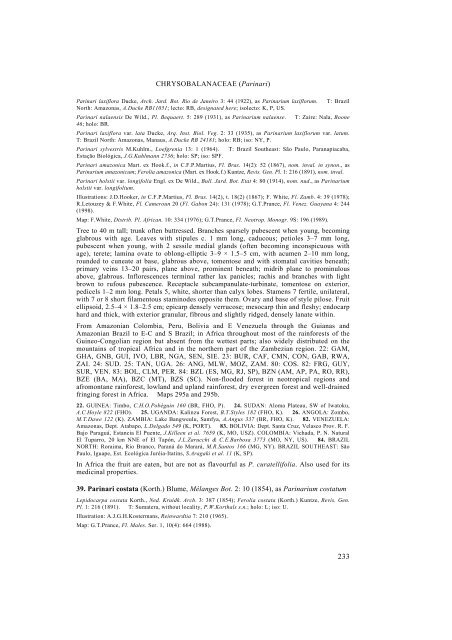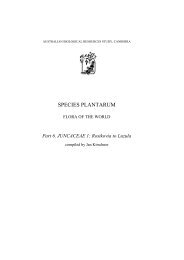Vol. 1 part 2 - Species Plantarum Programme
Vol. 1 part 2 - Species Plantarum Programme
Vol. 1 part 2 - Species Plantarum Programme
Create successful ePaper yourself
Turn your PDF publications into a flip-book with our unique Google optimized e-Paper software.
CHRYSOBALANACEAE (Parinari)<br />
Parinari laxiflora Ducke, Arch. Jard. Bot. Rio de Janeiro 3: 44 (1922), as Parinarium laxiflorum. T: Brazil<br />
North: Amazonas, A.Ducke RB11051; lecto: RB, designated here; isolecto: K, P, US.<br />
Parinari nalaensis De Wild., Pl. Bequaert. 5: 289 (1931), as Parinarium nalaense. T: Zaire: Nala, Boone<br />
46; holo: BR.<br />
Parinari laxiflora var. lata Ducke, Arq. Inst. Biol. Veg. 2: 33 (1935), as Parinarium laxiflorum var. latum.<br />
T: Brazil North: Amazonas, Manaus, A.Ducke RB 24181; holo: RB; iso: NY, P.<br />
Parinari sylvestris M.Kuhlm., Loefgrenia 13: 1 (1964). T: Brazil Southeast: São Paulo, Paranapiacaba,<br />
Estação Biológica, J.G.Kuhlmann 2736; holo: SP; iso: SPF.<br />
Parinari amazonica Mart. ex Hook.f., in C.F.P.Martius, Fl. Bras. 14(2): 52 (1867), nom. inval. in synon., as<br />
Parinarium amazonicum; Ferolia amazonica (Mart. ex Hook.f.) Kuntze, Revis. Gen. Pl. 1: 216 (1891), nom. inval.<br />
Parinari holstii var. longifolia Engl. ex De Wild., Bull. Jard. Bot. Etat 4: 80 (1914), nom. nud., as Parinarium<br />
holstii var. longifolium.<br />
Illustrations: J.D.Hooker, in C.F.P.Martius, Fl. Bras. 14(2), t. 18(2) (1867); F. White, Fl. Zamb. 4: 39 (1978);<br />
R.Letouzey & F.White, Fl. Cameroun 20 (Fl. Gabon 24): 131 (1978); G.T.Prance, Fl. Venez. Guayana 4: 244<br />
(1998).<br />
Map: F.White, Distrib. Pl. African. 10: 334 (1976); G.T.Prance, Fl. Neotrop. Monogr. 9S: 196 (1989).<br />
Tree to 40 m tall; trunk often buttressed. Branches sparsely pubescent when young, becoming<br />
glabrous with age. Leaves with stipules c. 1 mm long, caducous; petioles 3–7 mm long,<br />
pubescent when young, with 2 sessile medial glands (often becoming inconspicuous with<br />
age), terete; lamina ovate to oblong-elliptic 3–9 × 1.5–5 cm, with acumen 2–10 mm long,<br />
rounded to cuneate at base, glabrous above, tomentose and with stomatal cavities beneath;<br />
primary veins 13–20 pairs, plane above, prominent beneath; midrib plane to prominulous<br />
above, glabrous. Inflorescences terminal rather lax panicles; rachis and branches with light<br />
brown to rufous pubescence. Receptacle subcampanulate-turbinate, tomentose on exterior,<br />
pedicels 1–2 mm long. Petals 5, white, shorter than calyx lobes. Stamens 7 fertile, unilateral,<br />
with 7 or 8 short filamentous staminodes opposite them. Ovary and base of style pilose. Fruit<br />
ellipsoid, 2.5–4 × 1.8–2.5 cm; epicarp densely verrucose; mesocarp thin and fleshy; endocarp<br />
hard and thick, with exterior granular, fibrous and slightly ridged, densely lanate within.<br />
From Amazonian Colombia, Peru, Bolivia and E Venezuela through the Guianas and<br />
Amazonian Brazil to E-C and S Brazil; in Africa throughout most of the rainforests of the<br />
Guineo-Congolian region but absent from the wettest <strong>part</strong>s; also widely distributed on the<br />
mountains of tropical Africa and in the northern <strong>part</strong> of the Zambezian region. 22: GAM,<br />
GHA, GNB, GUI, IVO, LBR, NGA, SEN, SIE. 23: BUR, CAF, CMN, CON, GAB, RWA,<br />
ZAI. 24: SUD. 25: TAN, UGA. 26: ANG, MLW, MOZ, ZAM. 80: COS. 82: FRG, GUY,<br />
SUR, VEN. 83: BOL, CLM, PER. 84: BZL (ES, MG, RJ, SP), BZN (AM, AP, PA, RO, RR),<br />
BZE (BA, MA), BZC (MT), BZS (SC). Non-flooded forest in neotropical regions and<br />
afromontane rainforest, lowland and upland rainforest, dry evergreen forest and well-drained<br />
fringing forest in Africa. Maps 295a and 295b.<br />
22. GUINEA: Timbo, C.H.O.Pobéguin 160 (BR, FHO, P). 24. SUDAN: Aloma Plateau, SW of Iwatoku,<br />
A.C.Hoyle 822 (FHO). 25. UGANDA: Kalinzu Forest, B.T.Styles 182 (FHO, K). 26. ANGOLA: Zombo,<br />
M.T.Dawe 122 (K). ZAMBIA: Lake Bangweulu, Samfya, A.Angus 337 (BR, FHO, K). 82. VENEZUELA:<br />
Amazonas, Dept. Atabapo, L.Delgado 549 (K, PORT). 83. BOLIVIA: Dept. Santa Cruz, Velasco Prov. R. F.<br />
Bajo Paraguá, Estancia El Puente, J.Killeen et al. 7659 (K, MO, USZ). COLOMBIA: Vichada, P. N. Natural<br />
El Tuparro, 20 km NNE of El Tapón, J.L.Zarucchi & C.E.Barbosa 3773 (MO, NY, US). 84. BRAZIL<br />
NORTH: Roraima, Rio Branco, Paraná do Marará, M.R.Santos 166 (MG, NY). BRAZIL SOUTHEAST: São<br />
Paulo, Iguape, Est. Ecológica Juréia-Itatins, S.Aragaki et al. 11 (K, SP).<br />
In Africa the fruit are eaten, but are not as flavourful as P. curatellifolia. Also used for its<br />
medicinal properties.<br />
39. Parinari costata (Korth.) Blume, Mélanges Bot. 2: 10 (1854), as Parinarium costatum<br />
Lepidocarpa costata Korth., Ned. Kruidk. Arch. 3: 387 (1854); Ferolia costata (Korth.) Kuntze, Revis. Gen.<br />
Pl. 1: 216 (1891). T: Sumatera, without locality, P.W.Korthals s.n.; holo: L; iso: U.<br />
Illustration: A.J.G.H.Kostermans, Reinwardtia 7: 210 (1965).<br />
Map: G.T.Prance, Fl. Males. Ser. 1, 10(4): 664 (1988).<br />
233












